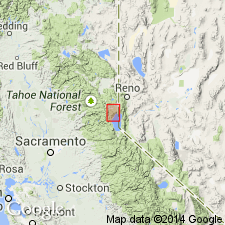
- Usage in publication:
-
- Tahoe City olivine latite member (informal)
- Modifications:
-
- Original reference
- Dominant lithology:
-
- Latite
- AAPG geologic province:
-
- Sierra Nevada province
Summary:
Pg. 1453-1464. Tahoe City olivine latite member of Lousetown Formation. Overlies Fir Crags gravel. Basal flow of Tahoe City olivine latites in northeast wall of Upper Truckee Canyon is oldest flow along the canyon as it gives potassium-argon age of 1.9 [Ma]. Several younger flows overlie dated flow, and their age is not known. Big Chief basalt (new) is probably younger than this dated flow, but is older than Tahoe City flow, cropping out in southwest wall of the canyon. At least 20 flows (or groups of flows) recognized in area. Nine flows (or groups of flows) are named and given informal member status in Lousetown Formation. Age is Early Pleistocene.
Named from occurrence in vicinity of Tahoe City, Truckee area, north of Lake Tahoe, [in sec. 6, T. 15 N., R. 17 E., Tahoe City 15-min quadrangle, Placer Co., northeastern CA].
Source: US geologic names lexicon (USGS Bull. 1350, p. 744); supplemental information from GNU records (USGS DDS-6; Menlo GNULEX).
For more information, please contact Nancy Stamm, Geologic Names Committee Secretary.
Asterisk (*) indicates published by U.S. Geological Survey authors.
"No current usage" (†) implies that a name has been abandoned or has fallen into disuse. Former usage and, if known, replacement name given in parentheses ( ).
Slash (/) indicates name conflicts with nomenclatural guidelines (CSN, 1933; ACSN, 1961, 1970; NACSN, 1983, 2005, 2021). May be explained within brackets ([ ]).

